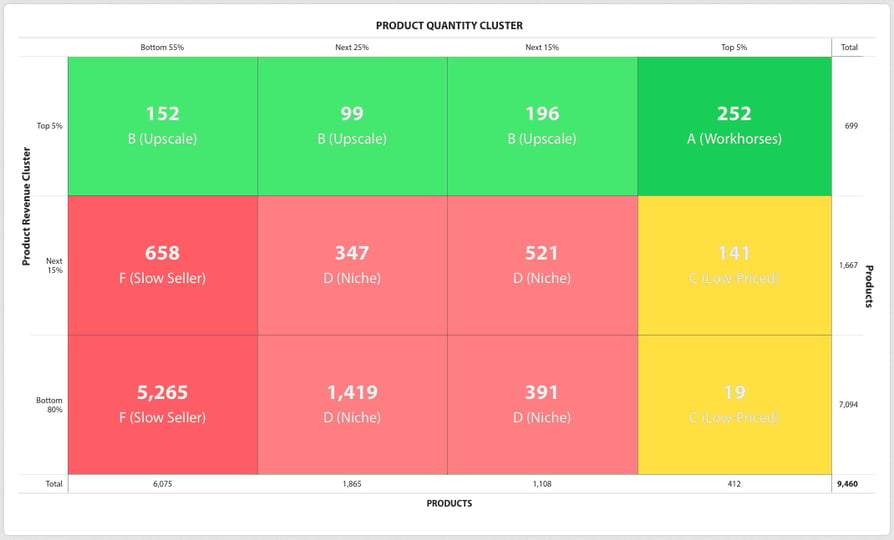The Christmas shopping season has begun – and online retailers everywhere are seizing the opportunity for the sale of the year. In fact: the myth, ‘Christmas shopping season’, has substance! With our benchmarking study from August, we illustrated that the gross order value during the Christmas season is 83% higher than during the rest of the year and that on average 38% more new customers can be generated.
Today, we would like to show you how you can bring your assortment ‘up to scratch’, just in time for the Christmas shopping season: With the right questions and intelligent clustering, you are on the path to boost your sales, increase profitability, minimize returns and ensure a quick inventory turnover.
ABC Cluster:
Which of my products are true ‘workhorses’? Where are inconvenient Slow Sellers hiding?
It is essential for every online retailer to know which products generate the most turnovers and which products exhibit the highest sales volume, to ensure effective and sustainable marketing.
Cluster your products by means of an ABC analysis, which many of you should recall having learned during your bachelor in business – in terms of both dimensions; turnovers and sales volumes! This way, you can see at a glance which products have strong revenues and sales volumes, also known as your ‘workhorses’ (A-segment), and find out where the ‘Slow Sellers’ (F-segment) are hiding, with poor performance in both turnovers and sales volumes.
Für jeden Onlinehändler ist es essentiell zu wissen, welche Produkte den meisten Umsatz generieren und welche Produkte die höchste Absatzmenge aufweisen, um ihre effektive Vermarktung nachhaltig sicherstellen zu können.
Cluster your products by means of an ABC analysis, which many of you should recall having learned during your bachelor in business – in terms of both dimensions; turnovers and sales volumes! This way, you can see at a glance which products have strong revenues and sales volumes, also known as your ‘workhorses’ (A-segment), and find out where the ‘Slow Sellers’ (F-segment) are hiding, with poor performance in both turnovers and sales volumes.
Instead of wasting time and money on weak F-products with unsatisfactory turnovers and sales volumes, ‘workhorses’ and ‘Upscale’ products (A- and B-segment) should be pushed.

Activity Cluster:
How does the turnover of individual products develop over time?
A few top-sellers can hold their status as A or B products after several years in the product range, other products, however, are strongly based off of trends: after only a few days, they can be found in the A- or B-segment, but quickly slide down to C, D or F classes a few weeks later.
Cluster your product portfolio after the ABC-segment (axis 1) and the number of days since first order (axis 2) and determine which articles should be classified as developing, sustainably successful or critical.
Fully stimulate the turnover potential of new A/B products and attract more customers through the trend! F products that are collecting dust in the inventory should be removed from the portfolio – analyze the potential of those products in regard to profitability and say good-bye to unwanted liabilities.
Inventory Range Cluster:
How large is the range of my stocked products?
Many retailers know this problem: high loss of sales through sold out A and B products. As a result of inadequate reports, many retailers neglect the inventory range of their high sales products, negatively influencing their delivery reliability and thus testing the customer’s patience – sometimes too much.
Cluster your products by storage segment (ABC cluster combined with the range in days) and find out where your procurement process can be optimized so no sales are lost.
Just-in-time procurement or increasing the stock safety is expensive, but can be quite profitable when applied in the right area.
Profitability Cluster:
How profitable are my products? Where should I continue to invest?
The be-all and end-all of your product line control is the knowledge of your products’ profitability. When the margins are high, the investment is worthwhile – elsewhere, money is wasted. (We will look over cases with temporary acceptance of poor profitability for the purpose of increasing market coverage.) As a matter of fact, many online retailers waste valuable resources on unprofitable F products, instead of concentrating their efforts on the profit-oriented optimization of unprofitable A/B products, as well as investing in further development of potential profit-leading products.
Cluster your products to the ABC classification (axis 1) and to profitability (axis 2). This creates a complete picture of the performance of your product portfolio.
Set yourself clear goals, invest only in the right articles and develop measures to increase the segment of high-profit products.
Return Cluster:
Between which return sections does my assortment range?
The return quote is one of the most important operating figures in online retail: What is left over from my successful marketing of my A products, if 90% are sent back?
Cluster your products on the axes “ABC Segment Group” and “Return Rate” and obtain significant return-segments: high performance products where a large part is sent back are now just as visible as products with relatively low return rates which allow access to unexplored potential by strengthening product marketing and increase sales.
Identify return kings and sales destroyers, invest in an optimized product presentation of high return rate A/B products, quickly get rid of F products with excessive return rates – in short: effectively decrease your return rates.
And now?
Easier said than done? Do you have the feeling that you have to analyze for days, before you can actually take measures and implement our tips? Good news: the described clustering methods are all available in minubo immediately. One click to the segment report, another to the more detailed selection report, and a third click to product export. And the best news: not only are those reports available for product segments, but also for various customer segments.
If you are interested, let our team personally demonstrate how minubo works - e. g. in one of our product tour webinars.


 nach Wunsch auch mit Videocall
nach Wunsch auch mit Videocall

